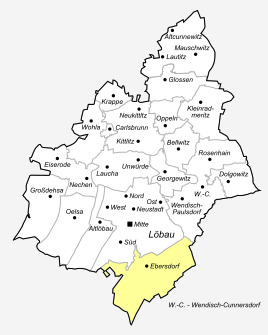Ebersdorf (Löbau)
|
Ebersdorf
City of Löbau
Coordinates: 51 ° 4 ′ 42 " N , 14 ° 40 ′ 55" E
|
|
|---|---|
| Area : | 7.11 km² |
| Residents : | 1282 (1990) |
| Population density : | 180 inhabitants / km² |
| Incorporation : | January 1, 1999 |
| Postal code : | 02708 |
| Area code : | 03585 |
|
Location of Ebersdorf in the area of the city of Löbau
|
|
Ebersdorf ( Upper Sorbian Habrachćicy ) is a district of the Saxon town of Löbau in the district of Görlitz in Upper Lusatia . The place is located south of the city center of Löbau and was incorporated into Löbau in 1999.
Prehistoric settlement
The corridors of today's Löbau district of Ebersdorf were already settled in the Stone Age, as is shown by finds of flint blades in the Ebersdorf sand pit. In the time of the Lausitz culture , which lasted from approx. 1300 BC. Until approx. 500 BC The corridors belonged to the immediate foreland of a fortified settlement on the summit of the Schafberg . The complex, which is one of the most strongly fortified settlements in the area, was probably inhabited by the Germanic tribe of the Semnones . After their departure, Sorbs settled in the region, followed by Franconian immigrants in the Middle Ages.
history
Ebersdorf was first mentioned in a document from Margrave Woldomars of Brandenburg in 1317 as Eversdorff when he referred eight villages in the region to the court of Löbau. The name is probably derived from a locator Eberhard. In 1334 the place Ebirsdorf , 1367 Ebirhardisdorf , 1491 Ewerßdorf and 1657 Ebersdorff is mentioned. Ebersdorf is a typical Waldhufendorf , which indicates a planned establishment by German settlers.
The village was owned by the middle-class Heller family from Görlitz, and from 1368 by the von Haugwitz family, followed by the von Gersdorff family at the end of the 15th century . In 1531 Ebersdorf came into the possession of the town of Löbau through an exchange. After the so-called Upper Lusatian Pönfall , the village fell to the Bohemian King Ferdinand I. It was not until 1576 that the city of Löbau managed to buy back the place for 6800 thalers. From then on, the manor remained with the Löbau council. Ebersdorf zu Löbau was also a church parish.
On September 9, 1813, the battle of Ebersdorf between Napoleon's troops and Prussian and Russian units under the leadership of General Jussofowicz took place in the town hall. A memorial inaugurated on September 7, 1913 on Obere Dorfstrasse commemorates the battle. There are also two memorial stones in the Liebesdörfel district for a fallen Polish Uhlan and a Russian Cossack officer.
In addition to agriculture, Ebersdorf developed in the 17th and 18th centuries. In the 19th century home weaving became an important occupation for the residents. In 1660 there were 17 weavers, in 1715 there were 43 weavers in the village. In the 19th century, the rapidly growing town received its own school, which was expanded in 1905 and 1978 and existed until 2002. From 1987 onwards, this was named after the first post-war mayor of Ebersdorf, Alwin Knöschke. The school was closed in 2002 and demolished in 2010. In its place there is now a senior citizens 'home run by the Workers' Samaritan Association. Since January 1, 1999, Ebersdorf has been part of the large district town of Löbau as a district.
Development of the population
| year | Residents |
|---|---|
| 1547 | 31 obsessed man |
| 1777 | 24 possessed men, 24 gardeners, 74 cottagers |
| 1834 | 906 |
| 1871 | 1,190 |
| 1890 | 1,288 |
| 1910 | 1,290 |
| 1925 | 1,264 |
| 1939 | 1,545 |
| 1946 | 1,760 |
| 1950 | 1,907 |
| 1964 | 1,630 |
| 1990 | 1,282 |
District of Liebesdörfel
The small district of Liebesdörfel, formerly also known as love houses, also belongs to Ebersdorf . The group of houses was built in the 18th / 19th century on Löbauer Wasser and was once the location of several water mills. In the former Beckelmühle, which was built in 1819, there is now a guest house. Down the river is the former tanner or room mill, where the Cunnersdorfer water merges with the Großschweidnitzer water to form the Löbauer water .
Jackel
The 389 meter high Jäckelberg lies southeast of the village. Here a memorial commemorates eight German soldiers who were convicted of attempted desertification by a field court on May 7, 1945 and shot here. The memorial consists of a field stone and is covered with a granite plaque with the inscription Here rest as victims of fascism 8 war-weary German soldiers, shot on May 7, 1945 . At the foot of the Jäckelberg stands the Jäckelbaude, a former consumer restaurant.
Individual evidence
- ↑ a b Ortschronik von Ebersdorf ( Memento of the original from June 4, 2012 in the Internet Archive ) Info: The archive link was inserted automatically and has not yet been checked. Please check the original and archive link according to the instructions and then remove this notice.
- ↑ a b c Information on the local history of Ebersdorf at www.loebaufoto.de
- ↑ StBA: Changes in the municipalities in Germany, see 1999
- ^ Measurement table sheet, Sect. Löbau, 1884
Web links
- Ebersdorf on the official homepage of the city of Löbau
- Ebersdorf in the Digital Historical Directory of Saxony
- Liebesdörfel district in the digital historical directory of Saxony


